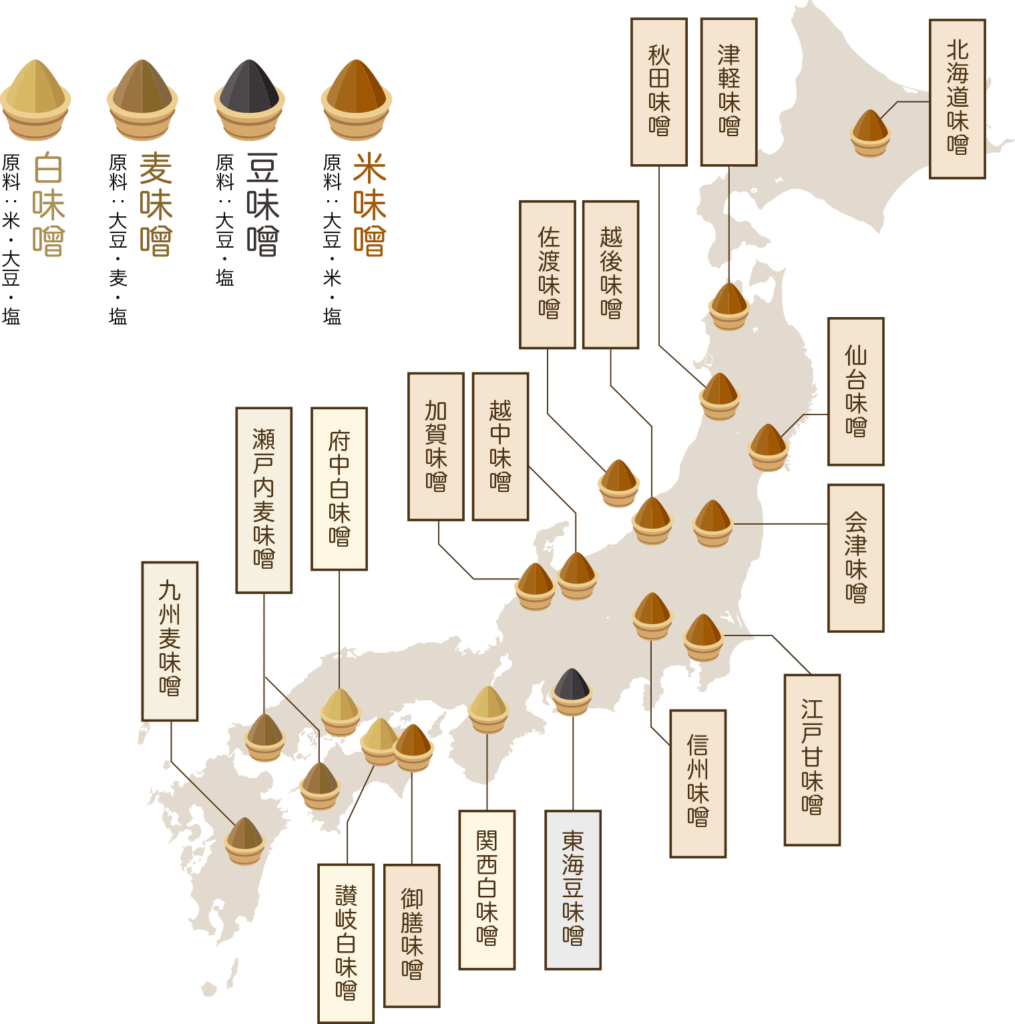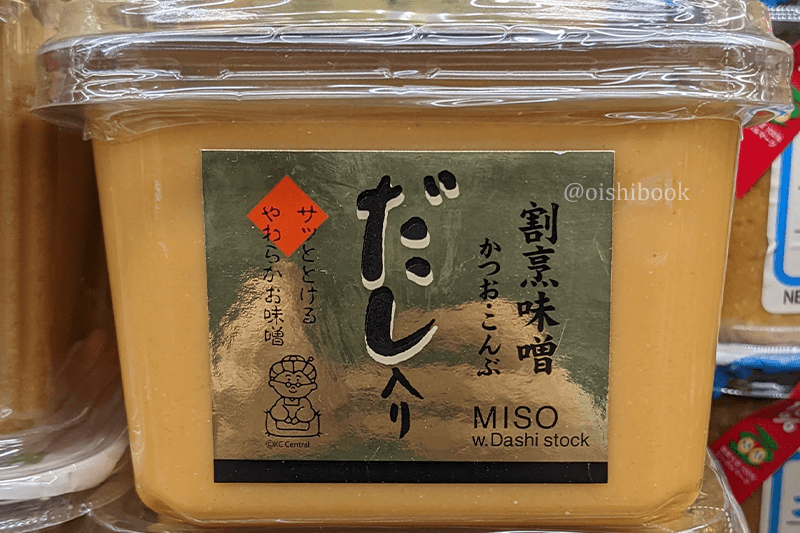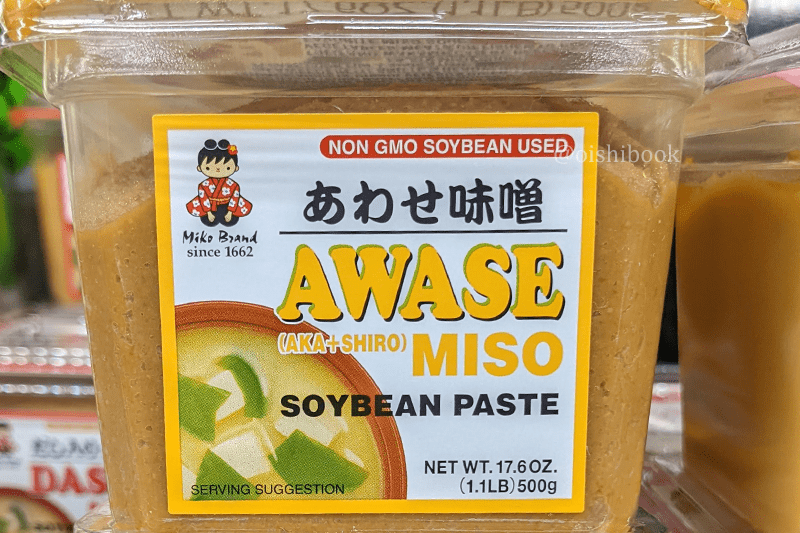Miso is one of the most important ingredients for Japanese cooking. Without Miso, we can’t talk about Japanese food culture!

It can be confusing buying miso for the first time. There are a lot of types of miso to choose from and you might not know which one is best for what you’re trying to cook. In this article, I’ll teach you about the types of miso, which one is the best for you, and some recipes that use miso so that you can find your favorite!
What is miso?
Miso is a paste made from soybeans, grains, koji, and salt and fermented for a few months or more. Miso has various types and colors, so you can choose depending on what you want to make or what flavor you prefer.
Koji
Koji is steamed grains or beans that are bred with microorganisms called aspergillus. If koji is made from rice, it becomes rice koji (kome koji, 米麹), if it is wheat, it becomes wheat koji (mugi koji, 麦麹), and soybeans become bean koji (mame koji, 豆麹).
Look at the image below! Different types of miso have been made depending on culture, background, and local people’s effort and preference.

There are three ways to categorize miso:
- Ingredients
- Colors
- Taste
Miso types by ingredients
There are 3 major miso types + mixed miso types.
Mixed Miso Types
- Combine 2 types miso from rice miso, barley miso, or soybean miso
- Comination of Rice koji, mugi koji, or mame koji
Miso by ingredients
| Miso | Ingredients | Production rate in Japan |
| 1. Rice Miso (Kome Miso 米味噌) | soybeans, salt, and rice koji | 80% |
| 2. Barley Miso (Mugi Miso 麦味噌) | soybeans, salt, and barley koji | 5% |
| 3. Soybean Miso (Mame Miso 豆味噌) | soybean, salt, and koji produced from soybeans | 5% |
80% of miso is categorized as rice miso which is made from soybeans, salt, and rice koji. So a lot of the miso sold at Asian grocery stores is most likely rice miso.
- Rice Miso (米味噌 : Kome Miso)
Made from soybeans, salt, and rice koji (米麹). Most miso you see at stores is rice miso. - Barley Miso (麦味噌 : Mugi Miso)
Made from soybeans, salt, and barley koji (麦麹) and takes one to three years to make. This has a very dark color and rich salty taste. - Soybean Miso (豆味噌 : Mame Miso)
Made from soybeans, salt, and koji produced from soybeans and takes one to three years to ferment.
Miso types by colors
You can also categorize miso by color. If you ever try to buy miso but you are not familiar, color one aspect that can make you confused so you don’t know which one to buy.
There are three major colors of miso: red, white, and blended. You might have seen yellow or black colors, but they are less common than these three color types.
Rice Miso by color
| Miso by taste | color | feature |
| Ama miso |
|
|
| Amakuchi miso |
|
|
| Karakuchi miso |
|
|
Barley Miso by color
| Miso by taste | color | feature |
| Amakuchi miso | white yellow color to reddish brown color | sweet and deep umami taste |
| Karakuchi miso | shiny deep reddish brown | deep umami taste |
Soybean Miso by color
| Miso by taste | color | feature |
| – | shiny deep reddish brown | deep umami taste |
Miso types by taste
There are three miso tastes which are sweet ( Ama Miso 甘味噌), mild (Amakuchi Miso 甘口味噌), and salty (Karakuchi Miso 辛口味噌). The flavor is based on the salt and koji ratio.
If two types of miso have the same ratio but one has higher koji content, then that one is sweeter.
- Ama Miso
Ama Miso contains around 5 – 7% salt and has the highest koji content (15 – 28 %) . This type is the sweetest miso of the three. - Amakuchi Miso
Amakuchi Miso contains around 7 – 12% salt and has low koji (12 – 17 %) . This type is the most used and sold one. - Karakuchi Miso
In general, Karakuchi Miso contains around 11 – 13% salt and has the lowest koji (5 – 10 %) . High sodium and a long fermentation process.
Miso’s effect (Is miso healthy?)
Yes! Miso is super healthy. Miso is defined as a great superfood. My grandparents used to tell me that if you have miso soup every day, you will live longer.
Some positive effects are:
- anti-aging
- reduced cold sensitivity
- helps with weight loss
- provides hormonal balance
- improved intestinal environment
However, despite these positives many people are still concerned about miso’s sodium content. It is said that the recommended daily salt limit is 8.0g for males and 7.0g for females. One bowl of miso soup has about 1.5g salt, so even if you have miso soup with every meal, it is only about 4.5g total. So it’s totally ok to eat lots of miso as long as you don’t have too much every day!
Q&A Often asked about miso
Lastly, here are some common questions people ask about miso!
1. How to store miso after I open?
After you open your miso, make sure you close it tightly and keep it in the fridge in order to stop the fermentation process and prevent mold growth. Some miso types can be stored at room temperature if you don’t open them but since there are so many kinds of miso, please check the label and make sure it’s okay before storing it at room temperature. If you are worried, you can store miso in the fridge even if it’s not opened yet!
You can also put miso in a freezer because it won’t freeze. But you should keep the temperature around 25F (-5C), otherwise miso’s best taste will go away.
2. Can miso expire?
Yes but it will take a long time to expire. Miso is a fermented food and contains a lot of salt, that prevents bacterial growth and is why you can use it for a long time. But please keep it in the fridge after opening and make sure to check the expiration date.
3. Which miso should I buy?
If you are confused on which type of miso is right for you, I recommend rice miso including dashi. It’s called dashi miso. I think this is sold in many grocery stores in the states so you can find it easily. The great thing about dashi miso is you can skip making dashi. In Japanese cooking recipes, there are a lot of times that you have to make dashi, but if you use dashi miso, it’s already done for you!

The other option to choose is Awase miso. Awase miso is mixed miso that is made from white miso and red miso. This has deep flavor and is easy to use.

4. What is dashi miso?
I love dashi miso. The big reason why I use it the most is dashi miso already includes dashi which is made from dried bonito flakes and dried kelp. When you make miso soup, the classic way is by making dashi first. But if you use dashi miso, you don’t need to make dashi. It saves a lot of time.
There are two types of dashi miso. One is paste type which is normal and the other type is a liquid type. I personally prefer the paste type over the liquid type. You don’t need to melt miso, so you don’t need to worry about the texture either way.
5. Where Can I buy miso?
I recommend you buy miso at Asian grocery stores if you can. Asian grocery stores typically have a larger variety. If you don’t have an Asian grocery store near you, then you can order miso online from an Asian grocery stores’ online site or Amazon.
In my opinion, buying miso on amazon is fine but it’s a little bit pricey and there isn’t enough variety so I haven’t tried it.
6. What can I make using miso? Some recipe ideas
I know so many people think miso is just for miso soup. Nope! There are so many dishes that you can add miso to and they became richer and tastier from the umami flavor it gives.
Here are some recipe ideas that use miso!
Miso Recipes
Leave a Reply
You must be logged in to post a comment.